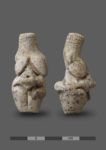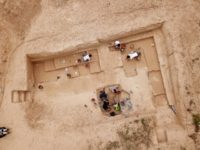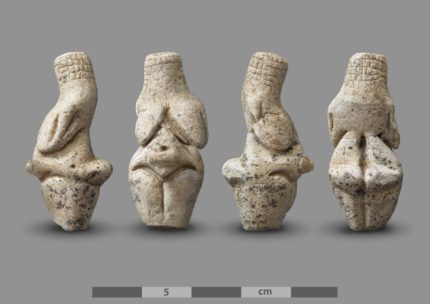 Archaeologists have unearthed an exceptional “Venus” figurine from the early Upper Paleolithic at the prehistoric site of Renancourt in Amiens, northern France.
Archaeologists have unearthed an exceptional “Venus” figurine from the early Upper Paleolithic at the prehistoric site of Renancourt in Amiens, northern France.
Sculpted in chalk and 4 centimeters tall, this “Venus” is steatopygic: the volume of the rear, thighs and breasts is hypertrophied. The arms are barely present, and the face is represented without lines. This sculpture adheres perfectly to the aesthetic canon of the Gravettian stylistic tradition, which includes the Venuses of Lespugue (Haute-Garonne) and Willendorf (Austria), as well the bas-relief Venus of Laussel (Dordogne). This “Venus” of Renancourt also has a surprising “hairdo” represented by a grid pattern of thin incisions similar to those of the Venus of Willendorf and, especially, of the Venus of Brassempouy (Landes), also known as the “Lady with a Hood.”
 She was found in a layer with organic remains that have been radiocarbon dated to 23,000 years ago, a period when the Gravettian hunter-gatherer culture thrived over a large portion of Europe. Gravettians produced large numbers of Venus figurines and 100 or so made of clay, ivory or stone have been discovered at Gravettian hunting camps from Portugal to Siberia. About 15 of them have been found in France, mostly in southwest, the most recent of them in 1959. Now the Renancourt site has single-handedly doubled those stats as archaeologists have found another 15 of the fertility deities in a mere five years of excavations.
She was found in a layer with organic remains that have been radiocarbon dated to 23,000 years ago, a period when the Gravettian hunter-gatherer culture thrived over a large portion of Europe. Gravettians produced large numbers of Venus figurines and 100 or so made of clay, ivory or stone have been discovered at Gravettian hunting camps from Portugal to Siberia. About 15 of them have been found in France, mostly in southwest, the most recent of them in 1959. Now the Renancourt site has single-handedly doubled those stats as archaeologists have found another 15 of the fertility deities in a mere five years of excavations.
This proliferation of figurines is accompanied by thousands of fragments of chalk that could be waste chips. Archaeologists think the site may have been used by the Gravettians as a figurine manufacturing workshop.

♫
“…what’s more….you’ve got arms!”
♫
That “hairdo”, along with similar depictions of hair in other statuettes from the time, could be intended to depict hair similar to the natural hair of sub-Saharan Africans today. This would be no surprise, considering that this was before the development of “European” skin color and other features. I expect that the Gravettians would have looked very “African” to our eyes.
The ghastly tradition of force-feeding young girls before marriage (cf. ‘Leblouh’) is a particularly ‘Saharan’(!) one.
Also, as I do have relatives from Jamaica, even people with ‘locks’ usually tend to have faces. Therefore, what we are dealing with here, could be a ‘face veil’, and the Gravettian equivalent of a ‘Rap video’ (“..we bring her over next summer, and this is what she looks like”).
Of course, it is problematic to draw parallels over several millennia, but I do wonder if there are parallels to e.g. the ‘sleeping girls’ from the Ħal-Saflieni Hypogeum in Malta.